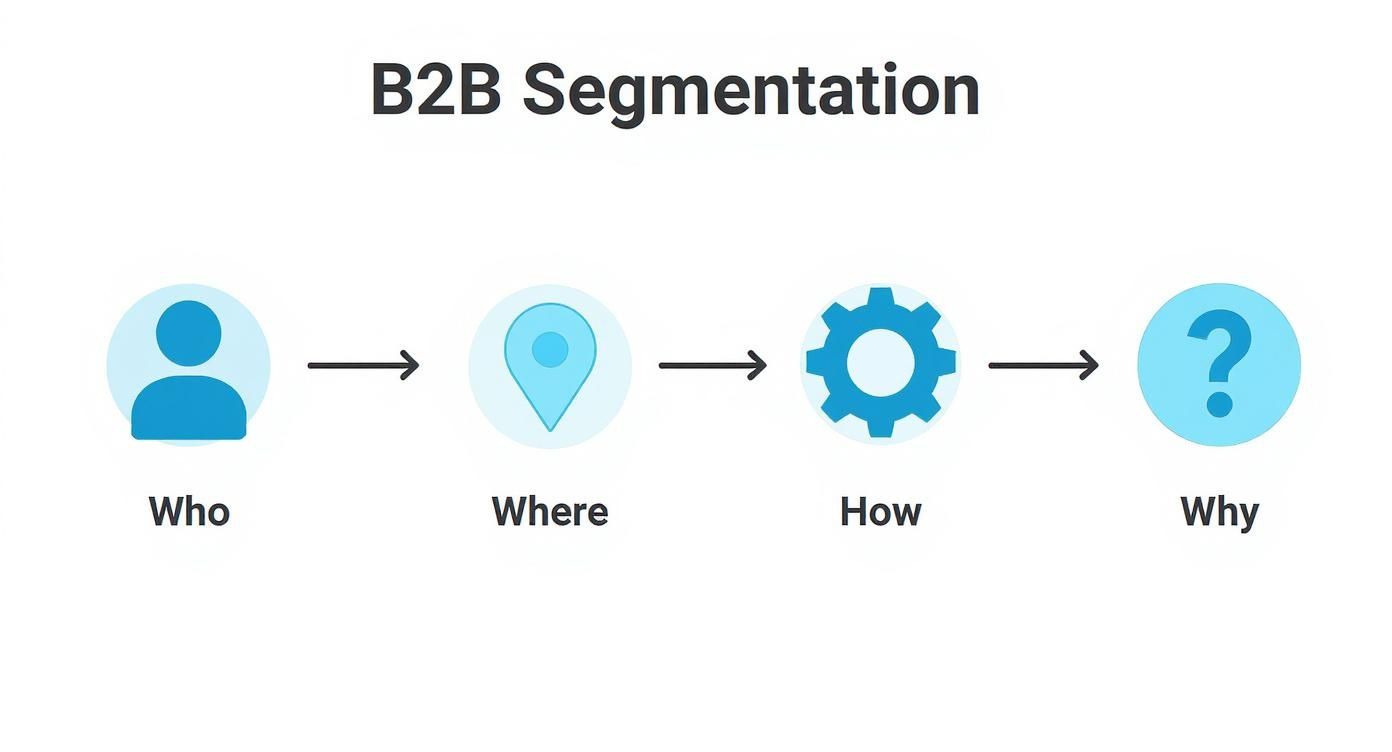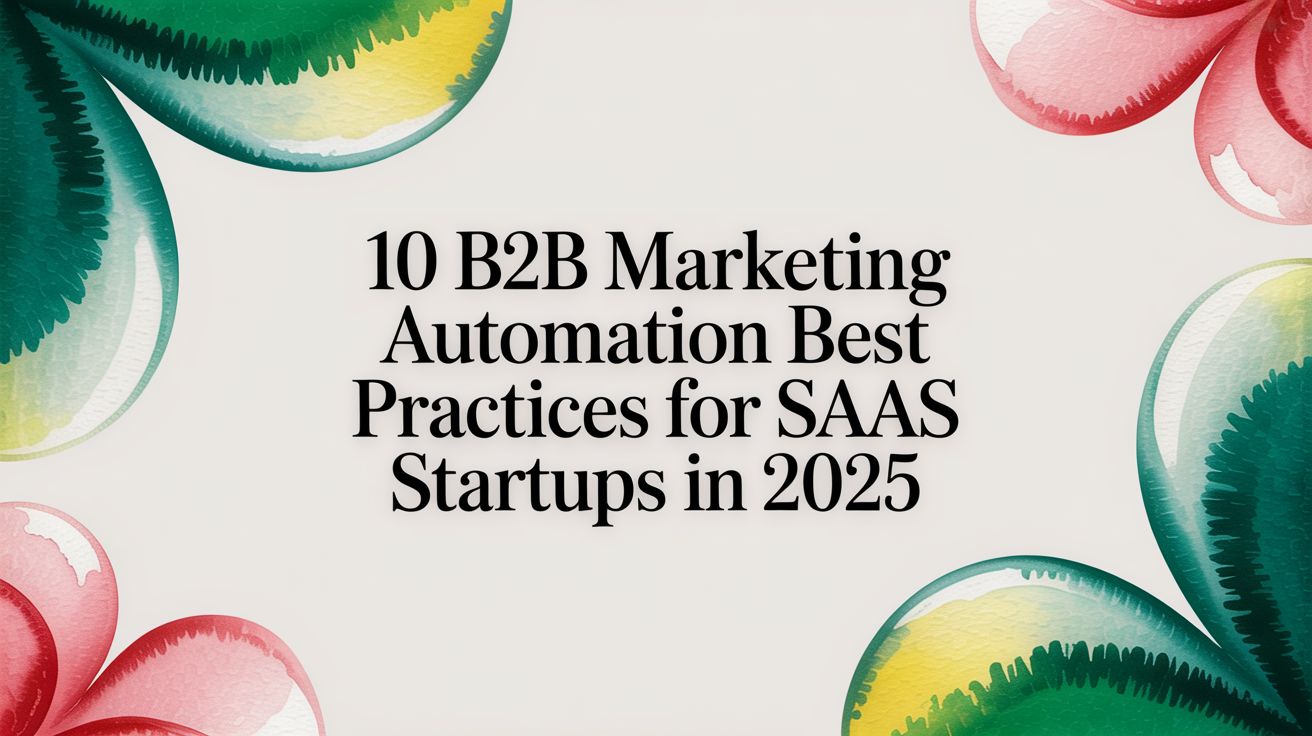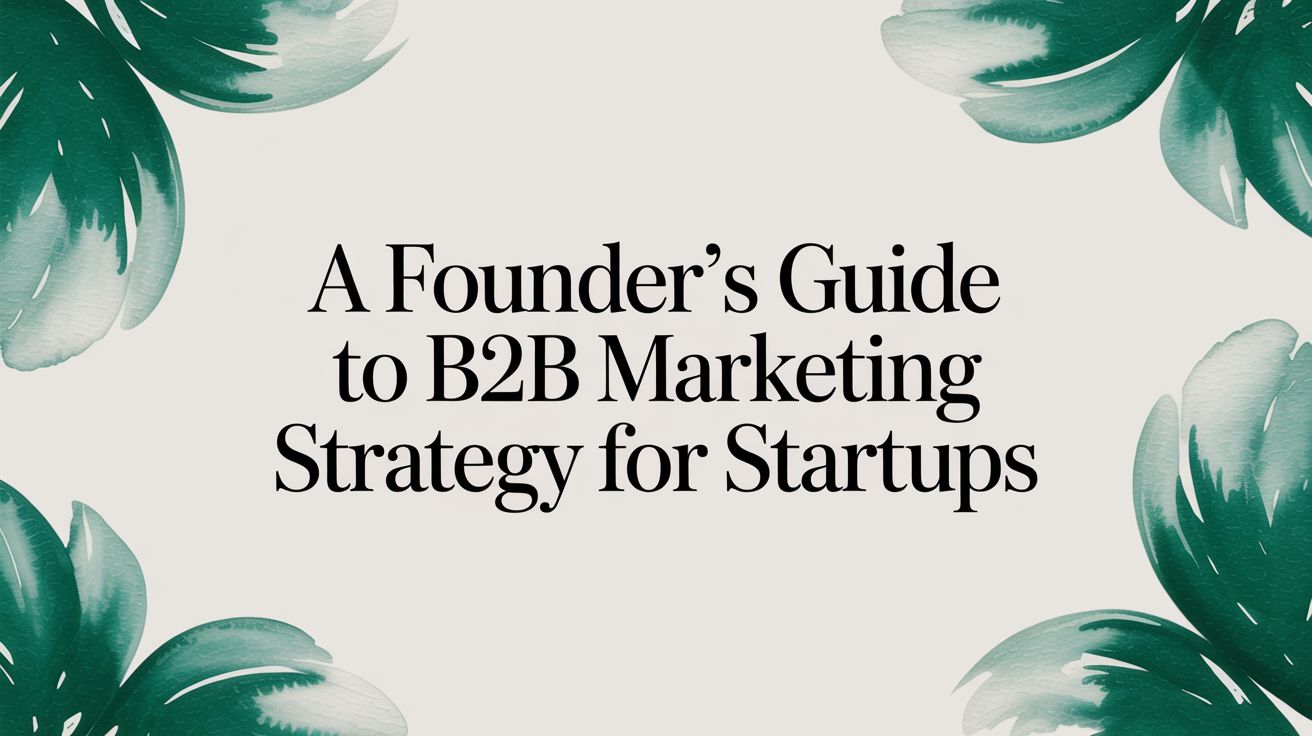Business to Business Market B2B Segmentation: A Growth Playbook
November 4, 2025

Let’s be honest. In the noisy world of B2B, just shouting your message from the rooftops is a surefire way to be ignored. You might as well be trying to sell to a crowded stadium where no one is listening.
Business to business market segmentation is the smart alternative. It’s about ditching the megaphone, finding the right decision-makers in that crowd, and having a direct, meaningful conversation. It’s a strategic way to divide a huge, diverse business market into smaller, more focused groups based on what they have in common.
Beyond One Size Fits All in B2B Marketing

Treating every business client like they're the same is a fast track to wasted effort and missed opportunities.
Think about a SaaS company that sells project management software. A generic message about "improving efficiency" is going to fall flat. Why? Because a small creative agency has completely different efficiency challenges than a multinational construction firm. Their workflows, team structures, and success metrics are worlds apart.
This is where segmentation proves its worth. Instead of one watered-down message for everyone, you can craft specific solutions that hit home with each group.
The True Purpose of Segmentation
Segmentation isn't just about tidying up your contact list; it's a core strategy for driving real, sustainable growth. The goal is to move past assumptions and actually understand your clients' worlds. When you get this right, you can:
- Speak Their Language: Address the specific pain points, goals, and industry jargon that matter to each segment.
- Create Relevant Value: Develop products, features, and content that solve actual problems for distinct business groups.
- Build Stronger Relationships: Show clients you get their unique situation, which builds trust and long-term loyalty.
This targeted approach has become non-negotiable as the global B2B eCommerce market has exploded. Valued at $13.29 trillion in 2019, the market is on track to hit $36.16 trillion by 2026, fueled by wildly different needs across sectors like manufacturing and healthcare. Segmentation is the only way to navigate a market this massive and varied.
Focusing Your Efforts for Maximum Impact
Ultimately, business to business market segmentation is all about focus. It helps you concentrate your most valuable resources—your team's time, your budget, and your talent—on the opportunities with the highest chance of success. By identifying your most valuable customer groups, you can stop broadcasting and start building genuine connections.
In B2B, you aren't selling to a faceless company; you're selling to people within that company who have specific problems they need to solve. Segmentation helps you figure out exactly who those people are and what keeps them up at night.
Once you’ve pinpointed these groups, you can deliver tailored messaging that cuts through the noise. This is critical because modern B2B buyers want simple choices that directly address their needs. It transforms your marketing from a speculative guess into a precise, value-driven conversation that fuels growth and builds lasting business partnerships.
The Core Models for B2B Segmentation
To really connect with business clients, you have to see the world from their perspective. Think of B2B market segmentation less like a single task and more like a set of specialized lenses. Each lens gives you a different view of your market, and when you combine them, you start to see a rich, multi-dimensional picture of your ideal customers.
These lenses are the core models of segmentation. Each one is designed to answer a fundamental question about the businesses you're trying to reach. Let's look at the four foundational approaches that will help you see your market with stunning clarity.
Firmographic Segmentation: The Who
Firmographics are almost always the starting point for B2B marketers. It's the business equivalent of demographics, grouping companies based on their core organizational traits. This model answers the most basic but essential question: "Who are these businesses?"
This is all about looking at objective, quantifiable data that describes a company.
- Industry: A software company selling compliance tools is going to have a very different conversation with a healthcare organization than it will with a financial services firm.
- Company Size: The needs, budget, and buying process of a 10-person startup are worlds apart from a 10,000-employee enterprise. This changes everything from product features to pricing.
- Annual Revenue: A company's revenue is a strong indicator of its budget, purchasing power, and how much it's willing to invest in a new solution.
Think of firmographics as the solid foundation for your segmentation strategy. It lets you quickly identify the most relevant markets and, just as importantly, rule out the ones that are a poor fit.
Geographic Segmentation: The Where
Next up is geography, which answers the simple question, "Where are these businesses located?" While it might seem straightforward, location can reveal a surprising amount about a company's challenges, operational realities, and even its culture.
This model zooms in on factors tied to a company's physical location:
- Country or Region: Businesses in the European Union have to navigate GDPR, while those in North America follow different data privacy rules. For a cybersecurity firm, that's not a small detail—it's a critical selling point.
- Climate: An HVAC manufacturer isn’t going to sell the same systems in Miami as it does in Minneapolis. They’ll segment B2B customers to offer product lines built for tropical versus cold climates.
- Cultural Norms: How business gets done can vary wildly from one country to another. These cultural nuances will shape your sales approach, marketing messages, and even relationship-building tactics.
Understanding the "where" helps you tailor your messaging, products, and support to fit local conditions and expectations, making your approach feel much more relevant.
Now, let's bring the four main segmentation models together to see how they stack up. Each approach offers a unique perspective on your market, and understanding when to use each one is key to building a powerful strategy. The table below breaks down the primary focus, common variables, and ideal use cases for each model.
Comparing B2B Market Segmentation Models
Segmentation ModelPrimary FocusExample VariablesBest Used ForFirmographicWho the business isIndustry, Company Size, RevenueInitial market qualification and broad targetingGeographicWhere the business isCountry, Region, ClimateTailoring offers to local regulations and needsBehavioralHow the business actsProduct Usage, Purchase HistoryIdentifying buying intent and engagement levelsNeeds-BasedWhy the business buysPain Points, Desired OutcomesCrafting resonant messaging and value props
As you can see, these models build on each other. Firmographics and geographics give you the basic details, but behavioral and needs-based models are where you find the insights that truly drive conversions. The best strategies often layer these approaches to create highly specific, actionable segments.
Behavioral Segmentation: The How
While the first two models tell you who and where your prospects are, behavioral segmentation digs much deeper to answer, "How do these businesses act?" This is a powerful approach that groups companies based on their actual interactions with your brand, how they use your product, and their buying patterns.
Behavioral data is all about intent. It shifts the focus from what a company is to what a company does, giving you powerful clues about its immediate needs and what it might do next.
A B2B SaaS company, for instance, could create segments based on:
- Product Usage: You might have a segment of "power users" who use every advanced feature—perfect for an upsell campaign. At the same time, a segment of "infrequent users" could get a targeted re-engagement campaign with training resources.
- Purchase History: Companies that frequently re-order supplies are prime candidates for a loyalty program. Meanwhile, one-time buyers might get a special offer to encourage a second purchase.
- Website Interaction: A prospect that keeps visiting a specific product page is practically waving a flag that says "I'm interested!" This is a hot lead that your sales team should prioritize immediately.
This approach is incredibly effective because it's based on real, observable actions, not just static profiles.
Needs-Based Segmentation: The Why
Finally, we get to the most powerful question of all: "Why do they buy?" Needs-based segmentation goes beyond simple data points to group businesses based on the fundamental problems they’re trying to solve or the specific outcomes they're chasing.
This is where things get really interesting in B2B. A company's decision to buy is rarely simple; it’s driven by a complex mix of operational headaches, ambitious growth goals, and the specific priorities of everyone involved in the decision.
Focusing on these precise needs is a game-changer. It helps you craft marketing that truly resonates, which naturally leads to higher conversion rates and a much smarter use of your budget.
This approach plugs directly into your messaging and positioning. You could create segments for companies whose primary need is cost reduction, risk mitigation, or driving innovation. Knowing that core driver tells you exactly how to frame your value proposition.
By truly understanding the "why," you can build powerful buyer personas that give your marketing and sales teams a massive advantage. For a deeper dive, check out our guide on using buyer personas to drive B2B success.
Your Step-by-Step Segmentation Process
Alright, let's move from theory to action. This is where the real work begins.
The idea of tackling a full business to business market segmentation process can feel huge, almost like you're trying to boil the ocean. But it's not some massive, complex project. Think of it more like building a roadmap to your best customers—one clear, intentional step at a time.
What follows is a repeatable process, something you can come back to again and again to bring clarity and focus to your marketing. We'll start with defining your goals and end up with powerful, living segments that will completely reshape how you connect with your market.
Let's walk through how to build this foundation for growth.
The infographic below lays out the core questions you'll be answering as you move through each stage.

As you can see, it's a logical flow. We start with the foundational questions about who and where your customers are, then dig into the more strategic insights of how they behave and why they buy.
Step 1: Define Your Objectives
Before you even think about touching any data, you need a destination. What, exactly, are you trying to achieve with segmentation? Without a specific goal, your efforts will be scattered and, frankly, a waste of time.
Your objectives will steer every single decision you make from here on out.
Start by asking yourself a few pointed questions:
- Are we trying to grab more market share in a specific industry?
- Do we want to improve customer retention by finally understanding what our users actually need?
- Is the goal to find and attract more high-value clients?
- Are we looking to sharpen our messaging to get better conversion rates?
Your answer becomes your North Star. It ensures the segments you create are directly tied to real business outcomes. For example, if your goal is customer retention, you’ll naturally focus more on behavioral and needs-based data from your current client base.
Step 2: Gather and Consolidate Your Data
With your objectives locked in, it’s time to collect the raw materials. This means pulling information from every corner of your business to get a 360-degree view of your market. Don't just stick to one type of data; the real power comes from blending different perspectives together.
Always start with your internal data sources. They're the most valuable and easiest to get your hands on.
- Your CRM System: This is a goldmine. It's packed with firmographic data (company size, industry) and behavioral gold (deal size, sales cycle length, purchase history).
- Sales Team Feedback: Your reps are on the front lines every day. They have priceless insights into customer pain points, the objections they hear constantly, and the real "why" behind a buying decision.
- Customer Support Tickets: These records are a direct line into the real-world challenges your customers face after the sale. You'll find common struggles, feature requests, and frustrations.
Once you have a handle on your internal world, start enriching it with external data. This could be anything from industry reports and market research surveys to public financial data. Combining what you know with what the market is telling you creates a much richer foundation to build on. To get a deeper look at this crucial first stage, check out our guide on how to identify target markets for B2B companies.
Step 3: Analyze the Data and Identify Patterns
Now for the fun part: finding the signal in the noise. This analysis phase is where you start to see distinct groups emerge from the crowd. You don't need a Ph.D. in statistics or complex software to get started—often, just sorting and filtering in a spreadsheet can reveal powerful insights.
Look for the common threads. Do your most profitable customers all come from the same industry? Do companies of a certain size always have the longest sales cycles? Are businesses in a specific region all facing the same challenges?
This is the creative part of the process, where data meets intuition. You're looking for clusters of businesses that not only share characteristics but also behave in similar ways or express similar needs.
A huge piece of this analysis is getting a deep understanding of your customers' challenges. This is where you can truly connect your solution to their world. A fantastic resource on this topic explains how to approach identifying customer pain points to make your segmentation that much sharper.
Step 4: Create and Profile Your Segments
Based on the patterns you've just uncovered, it's time to make your segments official. Give each one a descriptive name that instantly captures its identity, something like "Mid-Sized Tech Innovators" or "Enterprise Manufacturing Leaders."
Then, for each segment, build out a detailed profile. Go beyond the basic firmographics to paint a vivid picture of who these businesses are.
- Key Characteristics: What defines this segment? (e.g., industry, company size, revenue, location).
- Primary Needs & Pain Points: What specific problems are keeping them up at night?
- Buying Behavior: How do they make purchasing decisions? Who is involved in the process? What's their budget cycle like?
- Value Proposition: How does your solution specifically solve their unique problems?
Step 5: Validate and Activate Your Segments
This last step is the most critical. A segment is only useful if it’s actionable. You need to test your new creations in the real world. Can your sales team easily look at a prospect and know which segment they belong to? Can your marketing team build a targeted campaign for them?
Start small. Run a pilot campaign targeting one or two of your most promising segments. Measure the results obsessively. If the messaging hits the mark and you see higher engagement, you've validated your approach.
Use the feedback from this pilot to tweak and refine your profiles. Then, you can confidently roll out your new segmentation strategy across the entire organization. This is the step that turns all your hard work into a powerful, predictable engine for growth.
How Real Companies Win with B2B Segmentation
It’s one thing to understand the models and processes behind business-to-business market segmentation. It's another thing entirely to see how it can completely change a company's trajectory. These abstract concepts become powerful tools when you see them in the real world, turning struggling businesses into focused, high-growth machines.
Let's walk through three different stories of B2B companies that went from generic, spray-and-pray outreach to strategic success, all by finally embracing segmentation. These examples show just how much potential the right approach can unlock.
The SaaS Provider Overwhelmed by Churn
First up, imagine "SyncUp," a growing SaaS company with a collaboration platform. At first, their marketing was a wide net, targeting anyone who wanted to "work better together." This approach brought in a high volume of sign-ups, but their churn rate was a disaster. Small businesses, enterprise teams, and freelance creatives were all trying to use the platform in completely different ways, and the one-size-fits-all onboarding and support system was failing everyone.
SyncUp's leadership knew something had to give. They decided to lean into behavioral segmentation.
- The Approach: They dove into their user data, tracking how different types of companies were actually interacting with the platform. They quickly spotted three core groups: "Power Users" who lived in the advanced integrations every day, "Project-Based Teams" who used it intensely for 2-3 months and then went quiet, and "Minimalists" who only touched the basic chat functions.
- The Outcome: This insight was a game-changer. SyncUp created tailored onboarding for each segment. Power Users started getting emails about new advanced features. Project-Based Teams were offered flexible subscription pauses. Minimalists received tutorials on the exact features they were ignoring. The result? A 40% reduction in churn within six months and a huge jump in upsells to their Power Users.
The Manufacturer Missing Key Markets
Next, let's look at "Axle Heavy Industries," a manufacturer of specialized industrial equipment. For years, they sold to any manufacturing plant that would listen, but growth had completely flatlined. Their sales team was burning through time and effort on leads that went nowhere, and their marketing materials felt bland and uninspired. Their core problem was a total lack of focus.
They decided a firmographic approach was the key to bringing some much-needed clarity to their sales process.
By looking at the objective characteristics of their most successful and profitable clients, they could finally build a profile of what a perfect customer actually looked like. This moved their strategy from guesswork to a data-informed plan.
Diving into their sales data, they uncovered a startling fact: 80% of their most profitable deals came from a very specific niche—mid-sized food and beverage processing plants with 200-500 employees. This group had unique compliance needs and equipment durability requirements that Axle's products met perfectly, far better than other suppliers.
Armed with this knowledge, Axle retooled its entire go-to-market strategy. They developed industry-specific marketing materials, started attending food processing trade shows, and trained their sales team to speak the language of plant managers in that sector. This sharp turn led to a 30% increase in qualified leads and shaved nearly a month off their average sales cycle.
The Consulting Firm with a Vague Value Prop
Finally, there's "Momentum Advisory," a professional services firm offering business strategy consulting. Their website was a sea of broad promises about "driving growth" and "optimizing operations." They were struggling to stand out because their message sounded exactly like hundreds of other firms. They were completely lost in the noise.
Their breakthrough came from adopting a needs-based segmentation model. Instead of just describing what they did, they started focusing on why clients hired them in the first place.
Through a series of client interviews and surveys, they identified two primary needs driving their business:
- Crisis Navigation: These were clients facing a major market disruption or internal meltdown. They needed immediate, expert guidance to stabilize the ship.
- Scale-Up Strategy: These clients had a successful product but lacked the internal expertise to build a scalable sales and marketing function for rapid growth.
This simple but powerful distinction transformed their business. They developed two distinct service packages, each with its own messaging, case studies, and pricing. This allowed them to speak directly to a prospect's most urgent pain point. Momentum Advisory saw a 50% increase in proposal acceptance rates, as potential clients finally felt like someone understood their real problem. They also found that sharing these success stories was a powerful sales tool, a concept we explore more in our guide on turning customer wins into revenue growth.
Technology That Powers Modern B2B Segmentation

Let’s be honest: modern business to business market segmentation isn’t happening in a spreadsheet anymore. The days of manually sorting customer lists are long gone. Today, segmentation is powered by a connected ecosystem of tools that work together to turn raw data into strategic, actionable insights.
Think of this tech stack less as a collection of software and more as a single, intelligent system designed to find your best customers with pinpoint accuracy.
At the very center of this system is your Customer Relationship Management (CRM) platform, like Salesforce. This is your company's central nervous system, holding every critical piece of customer information—firmographics, sales interactions, purchase history, you name it. It's the rock-solid foundation for everything that follows.
Next up, you have Marketing Automation Platforms like HubSpot. These tools plug directly into your CRM and bring that static data to life. They track how prospects engage with your website, emails, and content, allowing you to build dynamic segments based on real-time behavior. Suddenly, you're moving beyond who a company is and focusing on what they do.
Want to dive deeper into these platforms? Check out our detailed guide on B2B marketing automation platforms.
Uncovering Deeper Insights
But what about the data you don't have? That's where Data Enrichment Services like ZoomInfo come in. These platforms are indispensable for painting a complete picture. They take your existing contact records and layer on thousands of external data points—everything from company revenue and tech stacks to recent funding rounds and hiring trends.
With enrichment, your basic profiles transform into rich, multi-dimensional portraits of your target accounts.
Now, you need a way to make sense of all this information. Business Intelligence (BI) Tools like Tableau or Power BI are your command center for analysis. They let you visualize complex datasets, spot hidden patterns, and see correlations you’d never find otherwise. This is how you discover which segments are quietly becoming your most profitable or which buying signals predict an upcoming purchase.
Technology transforms segmentation from a historical review into a forward-looking strategy. It empowers you to not only understand who your customers are today but to anticipate what they will need tomorrow.
The Rise of Predictive and AI-Powered Segmentation
The most exciting leap forward in segmentation technology is the arrival of Artificial Intelligence (AI) and predictive analytics. These aren't just buzzwords; they're game-changers. These systems chew through massive amounts of historical and real-time data to forecast future customer behavior, flag high-value prospects, and even tell your sales team the next best action to take.
This move toward intelligent segmentation is happening for a reason: buyer expectations have skyrocketed. The B2B marketing sector is projected to grow from USD 18.89 billion in 2024 to USD 30.79 billion by 2030, a surge driven by the demand for smarter, AI-powered marketing that delivers a seamless experience.
For a great resource on this, check out this excellent AI-driven personalization and segmentation guide. AI is the key to shifting from reactive analysis to proactive engagement, giving you a powerful strategic edge.
Got Questions About B2B Segmentation? Let's Clear Them Up.
Diving into business-to-business market segmentation is a smart move, but it almost always kicks up a few questions. That's perfectly normal. This final section is all about tackling those common "what ifs" and "how tos" with straight, practical answers.
Think of this as a quick-reference guide to help you sidestep common roadblocks. We'll cover the questions that pop up when you move from planning on a whiteboard to making segmentation work in the real world.
How Often Should We Revisit Our B2B Market Segments?
Your B2B market segments aren't a "set it and forget it" project. They're living profiles that need to evolve right alongside your market. A good rule of thumb is to schedule a full-blown review of your segmentation strategy at least once a year. This annual check-in keeps your segments aligned with your big-picture business goals.
But sometimes, a year is too long to wait. Certain events should be an immediate red flag, signaling that it's time to take another look.
Keep an eye out for these triggers:
- Major Market Shifts: Think new industry regulations, big economic swings, or supply chain headaches. Anything that fundamentally changes your customers' world can make your old segments obsolete overnight.
- Disruptive Tech: A competitor launches a game-changing feature, or a new piece of technology reshapes the industry. When this happens, your segments' needs and pain points will almost certainly change, too.
- Changes in Buying Behavior: Are you noticing clients are researching differently? Maybe their purchasing process has changed, or they're using your product in unexpected ways. These are clear signs their motivations are shifting.
- Campaigns That Just Don't Land: If your marketing messages are consistently falling flat with a specific segment, it's a strong hint that the profile you've built for them is out of date.
The key is to constantly monitor how each segment is performing. This proactive approach lets you make small adjustments before a little problem turns into a big one, keeping your marketing sharp and your sales team effective.
What Are the Most Common Mistakes in B2B Segmentation?
Knowing where others have gone wrong is the best way to get it right. Most segmentation projects don't fail from a lack of effort; they stumble into a few predictable traps. If you can steer clear of these, you're already way ahead of the curve.
The biggest mistake I see is creating segments that aren't actionable. A segment is only useful if your sales and marketing teams can actually do something with it—target them, message them, and sell to them. If you can't realistically identify and reach a group, then it's just a theoretical exercise.
A beautifully researched segment that your sales team can't use in the real world is worthless. The ultimate test of any segment is its practical application in driving business decisions.
Another classic blunder is relying only on firmographic data. Company size, location, and industry are fine for a starting point, but they tell you nothing about the "why" behind a purchase. If you ignore behavioral data or what your customers actually need, you're missing the insights that create real connections.
A few other common missteps to watch for:
- Creating Too Many Segments: This is a classic case of trying to be everything to everyone. It stretches your resources thin and guarantees you won't serve any single group particularly well.
- Forgetting to Get Sales Buy-In: If the sales team doesn't understand or believe in the segments, they won't use them. Period. Your entire strategy will fall apart right at the finish line.
- Skipping the Validation Step: You absolutely have to test your segments against real-world data and get feedback from actual customers. Otherwise, you might be building your entire go-to-market plan on a foundation of bad assumptions.
Can Small Businesses Effectively Use B2B Market Segmentation?
Absolutely. In fact, for a small business where every marketing dollar and every hour of a founder's time is precious, segmentation isn't a luxury—it's a survival tool. It’s what stops you from burning through your budget trying to talk to everyone at once.
You don't need fancy software or a huge team to get started. The trick is to start with what you already have. Look at your best customers right now. Who are they? What do they all have in common?
Start by asking these simple but powerful questions:
- What industry are they in?
- What's their typical company size?
- What's the one big problem our product solved for them?
The answers will help you build your first Ideal Customer Profile (ICP), which is really just your first, most important market segment. From there, you can dig into your CRM, review notes from sales calls, and use free tools like Google Analytics to find more insights. For a small business, segmentation is how you punch way above your weight.
Ready to build a go-to-market strategy that truly connects with your ideal customers? At Big Moves Marketing, I specialize in helping B2B SaaS and AI startups launch products with the positioning and sales tools that drive revenue. Let's create a plan that turns your vision into market success. Find out more at https://www.bigmoves.marketing.
%20-%20Alternate.svg)


%20-%20white.svg)